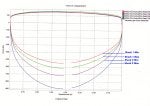Professional race car driver Jeff Altenburg once said, "Good shocks are probably the second most significant handling change you can make to a stock car, tires with an alignment being the most significant."
Unfortunately, picking out a good damper is almost never a self-informed decision. Without a dyno graph, you don't know what you're getting at all- and such graphs are hard to come by. Twin-tube, monotube, high-pressure gas, 32-step adjustability- for the most part, these terms are just marketing hype and should be ignored. No, really, even adjustability is just marketing hype until you can verify how it's implemented. Some adjustability is non-existent, and others work in a way that would just decrease overall performance. Seriously.
So, I thought I'd start a thread where we could compile together a bunch of strut dynos and compare them. Since it's hard to translate what feel the driver wants into a graph (unless you're an expert damper tuner, which I'm certainly not), I'm not sure if this thread will actually lead to any useful conclusions. To help out in this regard, here's an excellent article from Grassroots Motorsports that explains what to look for in a damper:
http://www.se-r.net/suspension/shock_tech.html
If you aren't familiar with shock dynos or shock tuning, or just want a refresher on why they're so important, I'd highly recommend giving that article a read. Here are some other good reads, in no particular order:
http://www.circletrack.com/techarticles/shock_absorber_shock_dyno/ (really basic article for newbie's)
http://www.circletrack.com/techarticles/139_0307_shock_absorber_tech/index.html (bigger article)
http://www.ozebiz.com.au/racetech/theory/shocktune.html (getting more technical)
http://www.wincom.net/trog/autocross_secrets6.html (opinion piece)
I basically grabbed every Impreza shock dyno I could find. Be warned, some of the graphs show bump resistance on top, others show rebound resistance up top. Some are in metric, some are in imperial. And the scale of the graphs vary greatly, some only dyno up to 5/in second and others much more. I had planned to take all this information and plot it all on one graph, so that all the dynos could be compared on the same scale and units, but I haven't found the time. Perhaps someone else is willing?
To start this discussion, here's a graph I found on Nasioc. I don't know the source (and thus can't verify it's accuracy), but it's been reposted a few times there.
Unfortunately, picking out a good damper is almost never a self-informed decision. Without a dyno graph, you don't know what you're getting at all- and such graphs are hard to come by. Twin-tube, monotube, high-pressure gas, 32-step adjustability- for the most part, these terms are just marketing hype and should be ignored. No, really, even adjustability is just marketing hype until you can verify how it's implemented. Some adjustability is non-existent, and others work in a way that would just decrease overall performance. Seriously.
So, I thought I'd start a thread where we could compile together a bunch of strut dynos and compare them. Since it's hard to translate what feel the driver wants into a graph (unless you're an expert damper tuner, which I'm certainly not), I'm not sure if this thread will actually lead to any useful conclusions. To help out in this regard, here's an excellent article from Grassroots Motorsports that explains what to look for in a damper:
http://www.se-r.net/suspension/shock_tech.html
If you aren't familiar with shock dynos or shock tuning, or just want a refresher on why they're so important, I'd highly recommend giving that article a read. Here are some other good reads, in no particular order:
http://www.circletrack.com/techarticles/shock_absorber_shock_dyno/ (really basic article for newbie's)
http://www.circletrack.com/techarticles/139_0307_shock_absorber_tech/index.html (bigger article)
http://www.ozebiz.com.au/racetech/theory/shocktune.html (getting more technical)
http://www.wincom.net/trog/autocross_secrets6.html (opinion piece)
I basically grabbed every Impreza shock dyno I could find. Be warned, some of the graphs show bump resistance on top, others show rebound resistance up top. Some are in metric, some are in imperial. And the scale of the graphs vary greatly, some only dyno up to 5/in second and others much more. I had planned to take all this information and plot it all on one graph, so that all the dynos could be compared on the same scale and units, but I haven't found the time. Perhaps someone else is willing?
To start this discussion, here's a graph I found on Nasioc. I don't know the source (and thus can't verify it's accuracy), but it's been reposted a few times there.









